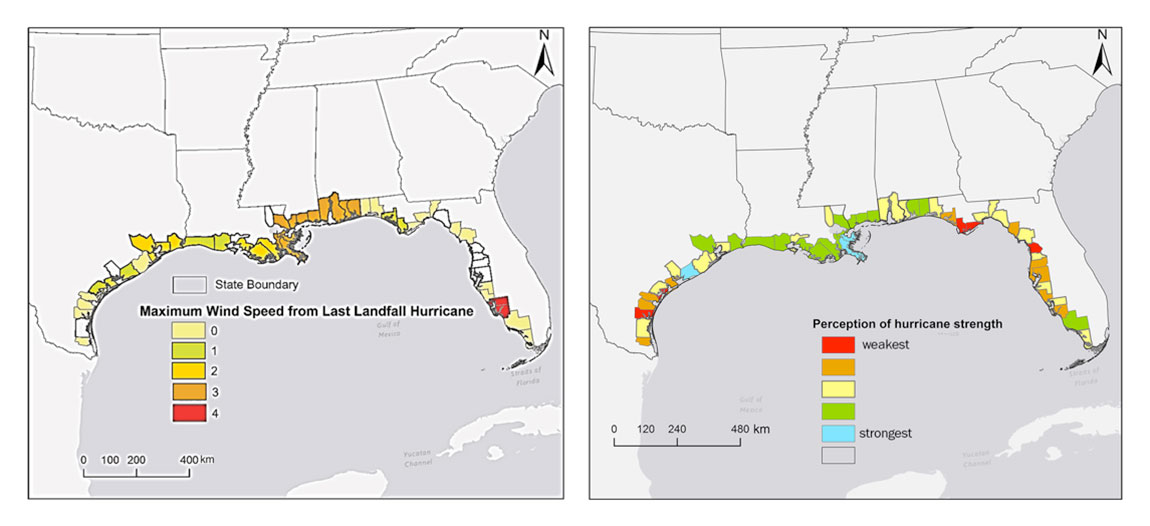In the last decade, hurricanes have been essentially inconsequential. Sandy was so mild by the time it hit New York City that Manhattan media had to invent the term "Super Storm" to talk about it, because tropical storm sounded too nice.
Yet they may be worse than decades ago, on average. Objective measurements of storm intensity are really only recent but they show that North Atlantic hurricanes have grown more destructive in recent decades. This makes sense, there are more people and that will mean more people with property damage when they hit. Yet coastal residents' views on the matter coincide with beliefs about global warming, how many hurricanes people have been through, and even their gender, according to a paper in the International Journal of Climatology.
The surveys they used were from Gulf Coast residents and what they found was predictable - the severity of the most recent storm a person weathered tended to play the largest role in determining whether they believed storms were getting worse. People want to live in important times, so young people will claim their hurricane was the worst thing ever while older people will claim it was Hurricane Agnes in 1972, or Andrew. The survey was taken before Sandy, so Hurricane Katrina was fresh in their minds.
Opinions came down along gender lines, if they believed in global warming, and their political party. A Democrat who believed in global warming felt like storms were much worse
Respondents' opinions also strongly differed depending on whether they were male or female, whether they believed in climate change and whether they were a Democrat or a Republican. For instance, people who believe in climate change were far more likely to perceive the increasing violence of storms than those who did not. The researchers noted that because climate change has become a politically polarizing issue, party affiliation also was an indicator of belief in strengthening storms.

"Understanding how people in coastal regions perceive the threat is important because it influences whether they will take the necessary actions to address that threat," said Ning Lin, the senior researcher on the study and a Princeton assistant professor of civil and environmental engineering.
"What you see is that there is often a gap between the reality of the storm trends and how people interpret those trends," said Siyuan Xian, a doctoral candidate in Lin's lab and co-lead author of the new paper.
To explore what influences perceptions of hurricane threat, the researchers analyzed data from the 2012 Gulf Coast Climate Change Survey to analyze Gulf Coast residents' beliefs about hurricane trends from 1992 to 2011. Louisiana State University and NOAA conducted the survey.
The survey focused on residents of Texas, Louisiana, Mississippi, Alabama and Florida, who lived in areas of the Gulf Coast that experienced at least one hurricane landfall over the 20-year period from 1992 to 2011. In addition to probing beliefs about hurricane trends, the survey gathered information on respondents' gender, political affiliations, opinions on climate change and other characteristics that might influence their perspective on hurricane trends.
While scientists continue to debate the impact of climate change on the frequency and strength of hurricanes, numerous studies of objective measures -- such as wind speed, storm-surge height and economic damage -- show that hurricanes are stronger than they were even a few decades ago.
For instance, eight of the 10 most economically damaging hurricanes since 1980 have occurred since 2004, according to the National Oceanic and Atmospheric Administration (NOAA). In constant dollars, Hurricanes Katrina (2005) and Sandy caused nearly $154 billion and $68 billion in damage, respectively, according to NOAA.
In comparison, the costliest storms of the 1990s, Hurricanes Andrew (1992) and Floyd (1999), caused $46 billion and $9 billion in damage (adjusted for inflation), respectively. Hurricane Patricia in 2015 was the strongest Western Hemisphere storm in recorded history with maximum sustained winds of 215 miles per hour.
As the intensity of storms has increased, government agencies and coastal residents must grapple with preparing for the next landfall. Residents must decide, for example, whether to invest in storm shutters, roof and wall fortifications, flood-proof flooring and other structural buffers. On a larger scale, coastal planners need voter support to implement land-use policies that take the threat into account and to invest taxpayer dollars into protection measures such as seawalls or sand dunes.
Understanding how people perceive the threat of hurricanes is crucial for predicting whether they will take them seriously, Xian said. Six hurricanes form each year in the North Atlantic on average, although as many as 15 have developed in a single hurricane season.
"If you perceive a higher risk, you will be more likely to support policies and take action to ameliorate the impacts," Xian said. "We wanted to know how people perceive the threat of hurricanes and what influences their perceptions. This information will help guide how agencies communicate the risk, and what policies and actions are proposed to make communities resilient to these storms."





Comments